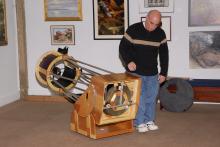Astronomy Merit Badge 3
Here's what we covered last time (week 3):
- The Earth rotates and revolves around the sun. The apparent motion of the sun, moon and stars each day is due primarily to rotation. If you look north at night, you will see the stars slowly rotate around the axis of the Earth's rotation (which is the point of requirement 4c, which was your homework last week).
- Our revolution around the sun causes the stars to be shifted a little each night, so we see different parts of the universe at different times of the year.


